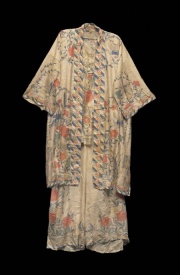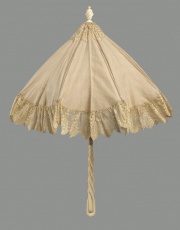Difference between revisions of "Pongee"
Jump to navigation
Jump to search
m (Text replace - "\[http:\/\/cameo\.mfa\.org\/materials\/fullrecord\.asp\?name=([^\s]+)\s(.*)\]" to "$2") |
|||
| Line 1: | Line 1: | ||
| − | [[File:Image3_802401.jpg|thumb| | + | [[File:Image3_802401.jpg|thumb|MFA Acc. #:2001.839]] |
| − | |||
| − | 2001.839 | ||
== Description == | == Description == | ||
| − | A fabric made from [[wild%20silk|wild silk]] with a nubby, irregular weave. Pongee originated in China. It is a soft, durable fabric that has poor washfastness when dyed. Pongee is used for garments, curtains, linings, and decoration. | + | 1. A fabric made from [[wild%20silk|wild silk]] with a nubby, irregular weave. Pongee originated in China. It is a soft, durable fabric that has poor washfastness when dyed. Pongee is used for garments, curtains, linings, and decoration. |
== Synonyms and Related Terms == | == Synonyms and Related Terms == | ||
| Line 11: | Line 9: | ||
[[File:45.581-SC119611.jpg|thumb|'''MFA Acc. #:''' 45.581]] | [[File:45.581-SC119611.jpg|thumb|'''MFA Acc. #:''' 45.581]] | ||
| − | == | + | == Risks == |
Ironing when wet will make pongee stiff. | Ironing when wet will make pongee stiff. | ||
| + | [[File:Image3_802521.jpg|thumb|Pongee]] | ||
| − | == | + | == Resources and Citations == |
| − | |||
| − | |||
| − | |||
| − | |||
| − | |||
| − | |||
| − | |||
* G.S.Brady, ''Materials Handbook'', McGraw-Hill Book Co., New York, 1971 | * G.S.Brady, ''Materials Handbook'', McGraw-Hill Book Co., New York, 1971 | ||
Revision as of 15:38, 6 December 2020
Description
1. A fabric made from Wild silk with a nubby, irregular weave. Pongee originated in China. It is a soft, durable fabric that has poor washfastness when dyed. Pongee is used for garments, curtains, linings, and decoration.
Synonyms and Related Terms
tussah; pongis (Esp.)
Risks
Ironing when wet will make pongee stiff.
Resources and Citations
- G.S.Brady, Materials Handbook, McGraw-Hill Book Co., New York, 1971
- Hoechst Celanese Corporation, Dictionary of Fiber & Textile Technology (older version called Man-made Fiber and Textile Dictionary, 1965), Hoechst Celanese Corporation, Charlotte NC, 1990
- Rosalie Rosso King, Textile Identification, Conservation, and Preservation, Noyes Publications, Park Ridge, NJ, 1985
- Edward Reich, Carlton J. Siegler, Consumer Goods: How to Know and Use Them, American Book Company, New York City, 1937
- Website address 1 Comment: www.fabrics.net


